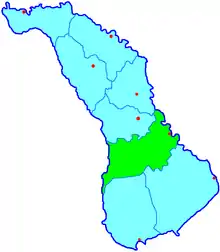Comrat Republic
The Comrat Republic (Gagauz: Komrat Respublikası; Romanian: Republica de la Comrat; Russian: Комратская республика, romanized: Komratskaya respublika) was an autonomous republic established in the village of Comrat, in the Bessarabia Governorate, in protest of the tsarist regime of the Russian Empire. It was created after a mutiny by Andrei Gălățeanu, a socialist revolutionary, with the support of the local Gagauz population. It lasted six days (from 6 January to 12 January) and is today viewed positively in Gagauzia (now in Moldova) as a premonition of the future Gagauz territorial autonomy.
Comrat Republic | |||||||||
|---|---|---|---|---|---|---|---|---|---|
| 6 January – 12 January 1906 | |||||||||
| Capital | Comrat | ||||||||
| Common languages | Gagauz, also Romanian, Russian | ||||||||
| Religion | Orthodox Christianity | ||||||||
| Government | Autonomous republic | ||||||||
| Leader | |||||||||
• 1906 | Andrei Gălățeanu | ||||||||
| History | |||||||||
• Declaration | 1906 | ||||||||
• Dissolution | 1906 | ||||||||
| Population | |||||||||
• 1906 estimate | 10,000 | ||||||||
| |||||||||
| Today part of | |||||||||
History

In 1905, following the arrival of the 1905 Russian Revolution, the Gagauz people began to call for the abolition of tsarism in the Russian Empire. Thus, Andrei Gălățeanu, a student at the Kharkiv Polytechnic Institute and a revolutionary socialist, created a clandestine organization in the village of Comrat, with a Gagauz ethnic majority. Gălățeanu began to urge the Gagauz peasant population to join his fight for rights.[1][2] Protests by them began, and they started demanding to stop the recruitment of Gagauz people into the Imperial Russian Army, education in the Gagauz language, free medical care and others. During this period, the idea of Gagauz territorial autonomy began to be considered for the first time.[3]
On 6 January 1906, a demonstration began in Comrat that escalated into mutiny, with Gălățeanu's supporters overthrowing the local authorities and proclaiming the Comrat Republic.[1][2] A committee under Gălățeanu's rule was established, and its first decisions were to repeal taxes, cancel IOUs and perform a land reform. Later, on 10 January, a Russian newspaper reported "Comrat, with a population of 10,000, is in the hands of the insurgents. Autonomy has been proclaimed. The authorities have been fired and arrested. The dragoons (a mounted infantry) are unarmed".[3]
On 12 January, after six days, the rebellion was suppressed. Gălățeanu and several of his companions were tried for sedition and deported to Siberia.[1][2][3]
During the times of the Soviet Union, the Comrat Republic was presented as a socialist and proletarian movement but not as an ethnic one. However, since the proclamation of the Autonomous Territorial Unit of Gagauzia, it has been regarded as a "sign" or "premonition", highlighting its socialist characteristics but especially the ethnic Gagauz ones.[4] Today, one of the streets of Comrat is named after Andrei Gălățeanu.[1][2]
See also
References
- "107 лет назад в Буджаке была провозглашена Комратская республика". vfokuse.md (in Russian). 9 January 2013. Archived from the original on 20 August 2017.
- "106 лет назад была провозглашена Комратская республика". Gagauzinfo.MD (in Russian). 9 January 2012.
- "Влияние русской революции 1905-1907 на Бессарабию". istoriagagauz.com (in Russian). 10 August 2012. Archived from the original on 19 February 2017.
- "URSS: le rêve turc des Gagaouzes Effrayée par la Moldavie nationaliste, déçue par le Kremlin et méfiante à l'égard de la Roumanie, la jeune "République de Gagaouzie" se tourne vers Ankara". Le Monde (in French). 28 March 1991.
